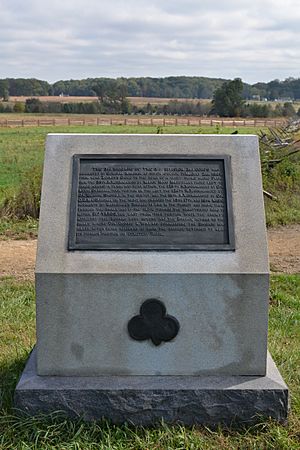George L. Willard facts for kids
George Lamb Willard (August 15, 1827 – July 2, 1863) was an officer in the United States Army. He fought in both the Mexican–American War and the American Civil War. Colonel Willard bravely led a group of soldiers called a brigade during the Battle of Gettysburg, where he was killed. A fort, Fort Willard, was named after him.
Quick facts for kids
George Lamb Willard
|
|
|---|---|

Col. George L. Willard
|
|
| Born | August 15, 1827 New York City, New York |
| Died | July 2, 1863 (aged 35) Gettysburg, Pennsylvania |
| Buried | |
| Allegiance | United States Union |
| Service/ |
United States Army Union Army |
| Years of service | 1847–1863 |
| Rank | |
| Unit | 15th U.S. Infantry 8th U.S. Infantry 19th U. S. Infantry |
| Commands held | 125th New York Infantry 3rd Bde, 3rd Div, II Corps |
| Battles/wars | Mexican-American War |
| Spouse(s) | Mary Gould Plum Willard |
Contents
Early Life and Military Start
George L. Willard was born in New York City on August 15, 1827. In 1847, when he was 20, he joined the 15th U.S. Infantry. He served in the Mexican–American War. By the end of that war, Willard had become a sergeant. Because of his good service, he was promoted to Second Lieutenant in the 8th U.S. Infantry.
Willard stayed in the regular army until the Civil War began. He rose to the rank of captain. He didn't want to leave his regular army job, so he missed the chance to lead a volunteer regiment at first. He served with his regular army unit during the Peninsula Campaign, a series of battles in Virginia.
Civil War Service
Harpers Ferry Experience
In late 1862, Willard was a major in the 19th U. S. Infantry. He helped create and became the colonel of the 125th New York Volunteer Infantry Regiment. He was allowed to keep his rank in the regular army.
Willard faced a tough time leading his new regiment at Harpers Ferry, West Virginia, in 1862. His new soldiers were not ready for battle. They became scared and scattered during the fighting on Bolivar Heights. They were especially frightened by bullets coming from the side (called enfilade fire) from Loudon Heights. When the army base was surrendered to Confederate General Stonewall Jackson, Willard and his men became prisoners of war.
After being released, the 125th New York was sent to Camp Douglas in Chicago, Illinois. They were later traded for captured Confederate soldiers. Then, they were sent to help defend Washington, D.C.. Willard later spoke to a military group investigating the surrender at Harpers Ferry. He was critical of how the commander, Colonel Dixon S. Miles, had acted.
Gettysburg Battle
Willard's brigade, sometimes called the "Harper's Ferry Brigade," joined the main Union army, the Army of the Potomac, on June 28, 1863. They became part of the II Corps. At first, other soldiers in the corps didn't trust them because of what happened at Harpers Ferry. They called them "Harpers Ferry Cowards." Willard's brigade had to prove their courage.
Willard became the leader of the brigade. It included the 39th, 111th, 125th, and 126th New York regiments.
The brigade marched north in the hot summer of 1863. They arrived at Gettysburg, Pennsylvania, late on July 1. They camped behind the Round Tops. Early on July 2, the brigade moved to Cemetery Ridge.
Late on July 2, the Confederate army attacked the Union left side. General Winfield Scott Hancock needed more soldiers. He sent for Willard's brigade. General Hays told Willard to take his men and "knock the Hell" out of the Confederates. General Hancock himself led Willard's brigade to the front lines.
Willard's men stopped the attack of Confederate General William Barksdale. Barksdale's soldiers had captured a Union position and were moving toward Cemetery Ridge. Willard ordered two of his regiments forward. They pushed the Confederates back. Some of Willard's men reportedly yelled, "Remember Harpers Ferry!" as they charged. The New Yorkers even got back some Union cannons that had been left behind.
However, they came under heavy fire from Confederate cannons. Willard had just ordered his men to pull back when an artillery shell hit him in the face. He died instantly. Colonel Eliakim Sherrill took command of the brigade.
Willard's body was taken back to his family. He was buried in Oakwood Cemetery in Troy, New York.
Memorials
- Fort Willard, a fort built to defend Washington, D.C., was named after Colonel George L. Willard.
- A small monument was placed on the Gettysburg battlefield in 1888. It marks the spot where Willard was killed.
- Camp #154 of the Sons of Union Veterans of the Civil War in Albany, New York, is named in Willard's honor.


